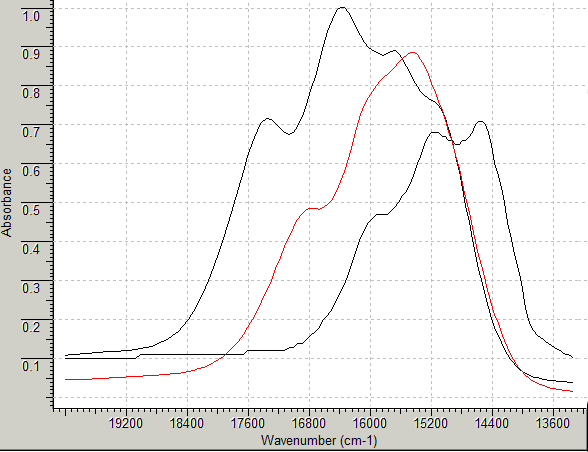The Department was fortunate to get a PE Lambda 19 UV/VIS/NIR machine from an IDB loan and the instrument was delivered on the 15th Nov, 1995. Version 1.1 of UVWinLab, the software that controls it, had bugs in the utility for JCAMP-DX conversion. Version 1.21 of UVWinLab arrived 19th January, 1996 and this solved most of the JCAMP-DX export problems, although in the headers it says 'exported from "IR" Winlab'! and uses nm and A abbreviations.
One of the PE standard data files (tartrazin 1.1944 mg/100ml)
shipped with the instrument has been converted to JCAMP-DX as an
example.
Another useful test sample is generated from the vapour above a
drop of benzene liquid.
The instrument came with a reflectance attachment. During the
testing and training exercises a spectrum showing the reflectance
of a piece of star apple skin was
recorded.
We will no longer be offering the NPJDX.DLL plugin or 32-bit
application JCAMPVW.EXE from the web site here, but will instead
be involved in upgrades to the CHIME plugin.
A condition of our contract is that a free version for
student and academic use will always be available from
MDL.
So, first install CHIME and then any of the spectra below can be displayed in your browser window. You can create your own pages by simply running a spectrum, exporting the data file as a JCAMP-DX file, then use the embed statement to load the file from your web page.
For a simple form to generate a simulated UV/Vis spectrum, try out this piece of JavaScript.

Visible spectra for some tetrahedral Co(II) complexes,
(solutions prepared in acetone or chloroform).
The acid hydrolysis of trans-[Co(en)2Cl2]Cl shows an increase in absorbance at 515 nm which can be used to monitor the kinetics of the reaction. The first and last scan from a typical student run are available for comparison. See the testdata files for a compound JCAMP-DX file containing multiple BLOCKS of a number of spectra from this experiment.
For a wide collection of spectral files, see the database
held at the
Lappeenranta University of Technology
Thanks to Jouni Haanpalo, from LUT, for 3 of his files giving
spectra of dyes used in confectionery. I have converted these to
JCAMP-DX format and they are available below.
 Return to Chemistry, UWI-Mona,
Home Page
Return to Chemistry, UWI-Mona,
Home Page
Copyright © 2006 by Robert John Lancashire, all rights reserved.
Created and maintained by Prof. Robert J. Lancashire,